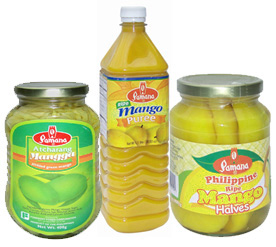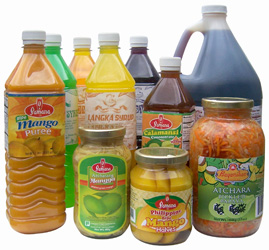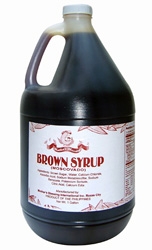philippine mango

besides being truly sweet - the philippine mango is also the most delicious
and the most tasty fruit, its flesh is soft and melting. it is free of the
fibers often found in other mango fruit varieties grown in other
countries such
as thailand and mexico.
low in calories and high in dietary fiber, mangoes are packed with
vitamins,
antioxidants and minerals. one small fruit provides a quarter of the
recommended daily allowance for vitamin c, nearly two thirds of the
daily quota
for vitamin a and good amounts of vitamin e and fiber.
mango concentrate is manufactured using mature
fruit. the fruit pulp is extracted,
followed by an enzymatic deactivation, evaporation, enzyme addition and
puree
concentration and sterilization. mango concentrate can be used in
beverages,
ice cream, jams, jellies, sauces and cereal bars.
mango puree is produced from fully, ripened mature
fruit. all processing of this fruit product is done under the guidelines
of
good manufacturing practices. mango puree is free of any additives or
preservatives. standard applications for the puree include: juice,
nectar, baby
food and jelly.
pickled papaya

the
native philippine papaya, according to a research done in comparison to
other
varieties of papaya that have been imported, has been found to have the
digestive enzyme "papain" ten
times more concentrated than in
other varieties of papaya. making the
philippine papaya more nutritious and richer in vitamin content.
research shows
that plants grown wild in their natural environment are richer in
nutrient and
vitamin content than plants cultivated outside their natural
environment. papaya
cultivated in the united states, for example, would not be nearly as
nutrient-rich as papaya grown wild in its natural tropical environment.
pickled products under the mother’s blessing brand:

green mango (atsarang manga); bamboo shoot (atsarang labong);
water cabbage (atsarang kangkong); bitter melon (atsarang ampalaya);
coconut pith (atsarang ubod)
syrups
calamansi

calamansi, a native citrus plant in the philippines and
china, is cultivated
in southeast asia and elsewhere as an important crop. the tree, which is
often
trained as a bonsai, will bloom year-round; filling the air with the
aroma of
citrus blossom. flower and fruit often will appear at the same time.
mature
fruit can be produced year round.
the juice is primarily valued for making acid beverages. it is often
employed like lime or lemon juice to make gelatin salads or desserts,
custard
pie or chiffon pie.
moscovado

a type of unrefined brown sugar with a strong molasses
flavor, which became one of the most prominent export commodities of the
philippines. unlike
most other brown sugars, which are made by adding molasses to refined
white
sugar, muscovado takes its flavor and color from its source, sugarcane
juice. it offers good resistance to high temperatures and has a
reasonably long shelf life. muscovado is one of the popular syrup
flavors made
by mother’s blesssing because it goes well with coffee, tea and
other beverages. other syrup flavors processed by mother’s blessing are:
jackfruit, melon, ube and buko pandan
ubod
also known as coconut pith or more
popularly known as heart of palm is the tasty “heart” of a coconut fruit. out
of this
coconut pith can be produced coco
pickles, guinatan and lumpia. actually, ubod is considered
one of the finest vegetables in the philippines. it can be served in
many appetizing ways. cubed in fairly large bits, it makes wonderful
addition
to spanish rice, or in their long strips, to arroz a la cubana. as a
salad, it
is mixed with mayonnaise or thousand island dressing and heaped onto
lettuce
leaves, red pepper, chopped spring onions, paprika, or a combination of
some of
those may be used to garnish this all-white salad. pickled ubod has been
proven
to be very delicious.
|
